Brands and content creators often find themselves on a treadmill of content creation, struggling to keep up with the appetite of their audiences. But what if we told you that the secret to proactively meeting this challenge does not involve creating new content? Yes, repurposing content for social media has emerged as a groundbreaking approach so that you can leverage existing content and redefine it for enhanced reach and deeper engagement.
It is a tried-and-tested strategy that not only streamlines content creation but ensures that every piece is optimized to its fullest potential on the dynamic stage of social media.
In fact, 48% of marketers find content repurposing to be a time-efficient strategy, as it eliminates the need to create new content from scratch.
In this blog, let us break down the process of repurposing content for social media with some effective strategies.
The Many Benefits of Repurposing Content for Social Media
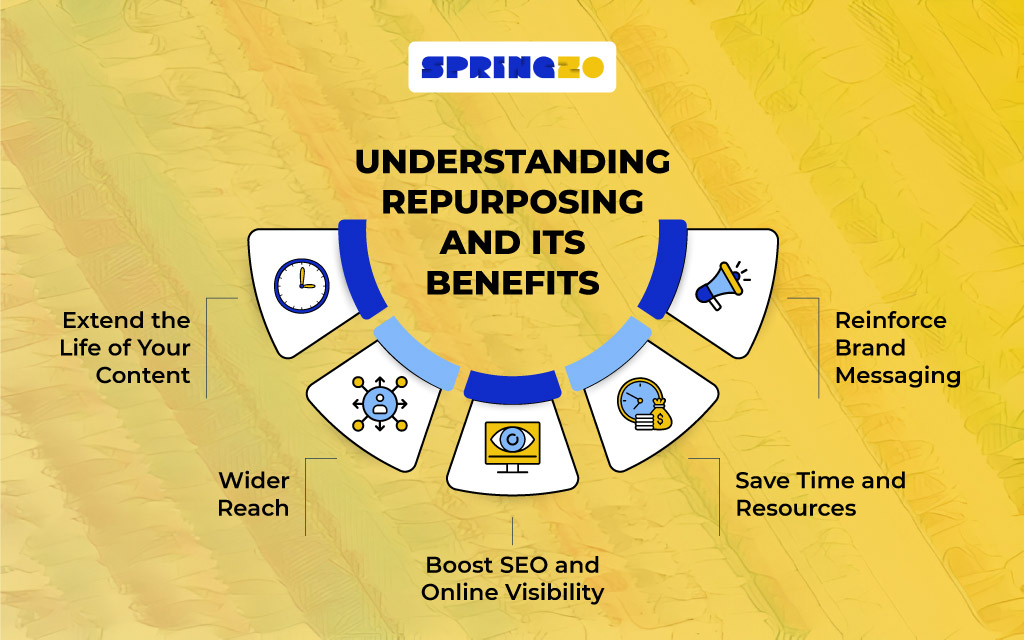
At its core, repurposing content for social media is about taking an existing piece of content and molding it to fit diverse platforms and formats.
It’s not recycling; it’s a strategic reinvention. The benefits of repurposing content for social media are multifaceted:
1. Extend the Life of Your Content
A single piece of content, when repurposed, can have its lifespan significantly elongated, making your effort more sustainable over time.
2. Reach Different Segments of Your Audience
Not everyone digests content the same way. By altering the format or channel, you cater to varied preferences and behaviors, ensuring broader engagement.
In fact, According to the Semrush Content Marketing 2023 survey, 73% of respondents identified organic social media posting as a top channel for maximizing content reach.
3. Boost SEO and Online Visibility
Repurposed content can rank for a myriad of keywords, granting more opportunities for your brand to shine in search results.
4. Save Time and Resources
Instead of starting from ground zero each time, leveraging what you’ve already created provides a head start, optimizing both time and cost.
5. Reinforce Brand Messaging
Consistency is key in branding. By repurposing content for social media, you can emphasize core messages across platforms, ingraining them more deeply in the audience’s consciousness.
Social Media Platforms and Their Unique Demands
Each social channel has its distinctive character, favored content type, and audience behavior. By honing in on these specifics, you can tailor your repurposed content to fit like a glove, ensuring maximum impact.
1. Facebook

Historically the juggernaut of social platforms, Facebook favors a mix of content – from videos to long-form posts. Given its diverse user base, repurposing content for social media here means crafting pieces that appeal to various age groups, interests, and behaviors.
2. Instagram

With its visual-first approach, Instagram thrives on compelling images, stories, and, increasingly, video content, especially through Reels. Repurposing content for this platform often entails a strong visual focus, making aesthetics paramount.
3. X (formerly Twitter)

In the realm of real-time updates and bite-sized content, X (erstwhile Twitter) values brevity. A DemandSage report suggests 40% of users purchase a product after seeing it on Twitter. So short text, engaging GIFs, and quick video clips dominate this platform. When repurposing content for social media on Twitter, think of concise content and timely delivery.
4. LinkedIn
The common playground of domain experts and industry professionals, LinkedIn gives priority to first-hand experiences, industry insights, long-form articles, and B2B content. Repurposed content here should resonate with professionals and industries, leaning on thought leadership.
In fact, According to Sprout Social reports, LinkedIn stands out as a premier platform for marketing and lead generation, with 40% of B2B marketers rating it as the top channel for securing high-quality leads.
5. Pinterest
A visual discovery engine at heart, Pinterest is all about infographics, how-to guides, and visually rich pins that inspire action.
If you are repurposing for Pinterest, think about content that offers value and ignites inspiration.
6. TikTok
TikTok is predominantly video-centric and teeming with Gen Z audiences and young millennials. The newcomer platform that has taken the world by storm, valuing creativity, trends, and authenticity.
Repurposing content for this platform is all about tapping into current trends and presenting them in entertaining, short video formats.
Repurposing Content for Social Media: Minute-Made Strategies
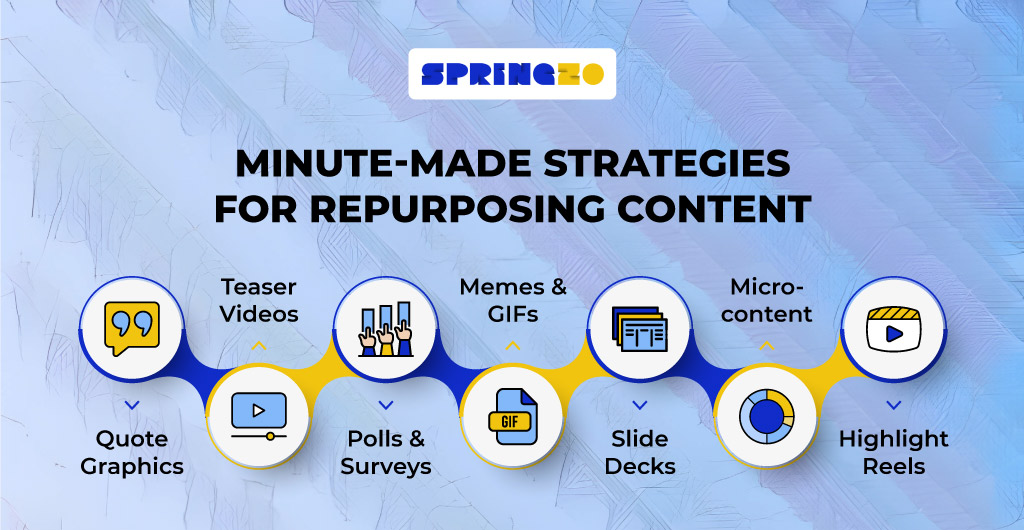
Now, the question is, how do you achieve accelerated content creation? The answer lies in repurposing content for social media with these strategies :
1. Quote Graphics
Delve into your long-form content and extract compelling quotes or statements. With minimal design effort, these can be turned into impactful quote graphics. They’re visually engaging and encapsulate the essence of your message in bite-sized formats – perfect for repurposing content for social media platforms like Instagram or Twitter.
2. Teaser Videos
According to the Semrush Content Marketing 2023 survey, 40% said creating more video content improved their content marketing efforts. The power of video content in today’s digital landscape cannot be overstated.
Use accessible online tools to transform your articles into short teaser videos, emphasizing key highlights. This is a fantastic way to pique interest and drive traffic back to the full content piece.
3. Polls & Surveys
Data-driven content, especially statistics, can be repurposed into interactive polls or surveys on platforms like Instagram Stories or Facebook. It’s a great way to engage your audience and invite participation.
4. Memes & GIFs
Humor is a universal language. Identify witty or amusing sections of your content and morph them into memes or GIFs. Such content often enjoys higher shareability, especially on platforms like Twitter or TikTok.
5. Slide Decks
A detailed article or a research report can be dissected into succinct points and presented as slide decks. Platforms like LinkedIn or Instagram Stories are perfect for this format, allowing for higher information consumption and brand recognition.
6. Micro-content
In an age of dwindling attention spans, micro-content reigns supreme. Extract key facts, statistics, or intriguing points from your content and share them as standalone posts. This strategy is particularly effective when repurposing content for social media channels that favor quick reads, like Twitter.
7. Highlight Reels
If you’ve hosted a webinar or a long video session, create quick highlight reels that capture the crux of the event. Such reels offer attendees a recap and provide a glimpse of those who might have missed out, prompting them to engage with the full content.
Repurposing Content for Social Media: 5 Tips for Better Engagement
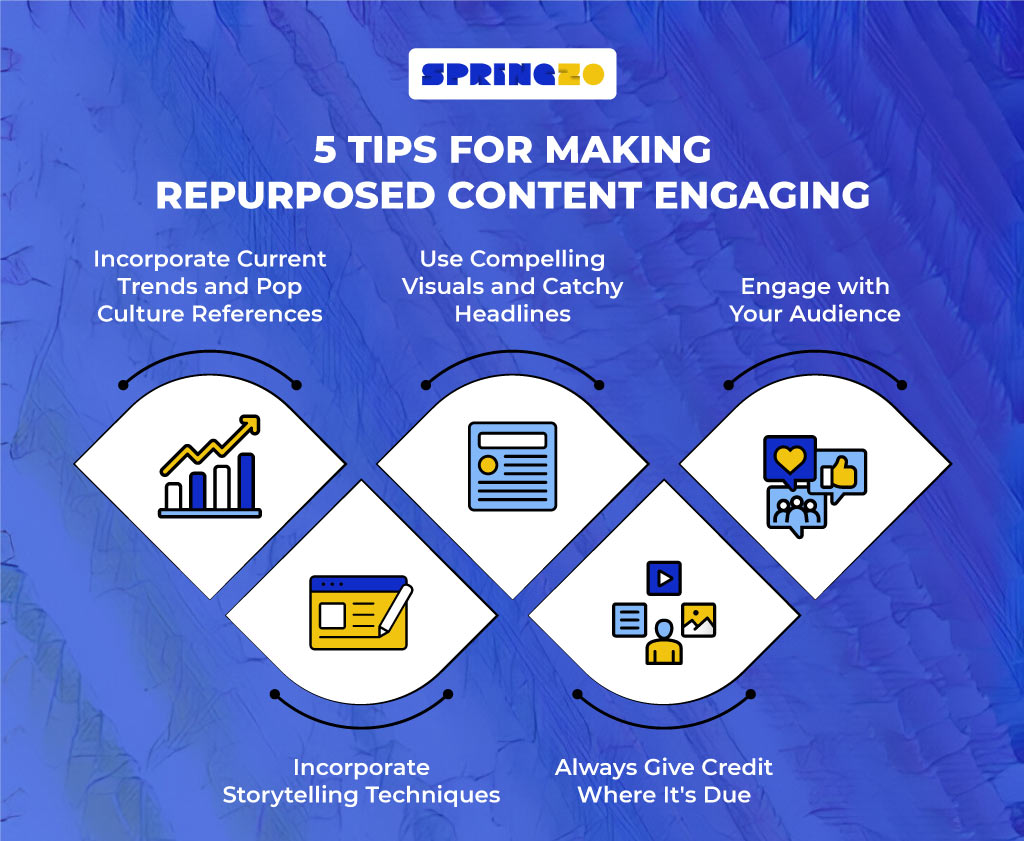
The success of repurposing content for social media hinges on how well you adapt and elevate the original piece for new platforms and audiences. Keeping these tips at the forefront of your strategy ensures that your content remains engaging, fresh, and ever-resonant:
1. Incorporate Current Trends and Pop Culture References
The digital world is ever-evolving, and what’s trending today might be obsolete tomorrow. When repurposing content for social media, weave in contemporary trends or pop culture nods. This makes your content relevant and showcases your brand’s finger-on-the-pulse awareness.
2. Use Compelling Visuals and Catchy Headlines
A picture is worth a thousand words, and a captivating headline is the hook that draws readers in. Enhance your repurposed content with high-quality visuals and attention-grabbing titles to stand out in the cluttered social media landscape.
3. Engage with Your Audience
Engagement is the cornerstone of successful social media content. Prompt conversations, ask thought-provoking questions or encourage feedback. When repurposing social media content, it’s an opportunity to revisit and rekindle the dialogue around a topic.
4. Incorporate Storytelling Techniques
Narratives have a unique power to connect emotionally. Even if your content is data-driven or factual, weave in storytelling elements to make it more relatable and memorable.
5. Always Give Credit Where It’s Due
Integrity in content creation is non-negotiable. Always ensure proper attribution if your repurposed content involves third-party or user-generated content. Not only is this ethically right, but it also fosters trust and transparency with your audience.
Repurposing Content for Social Media: Tools That Speed Up Process
Here’s a breakdown of some indispensable tools that every content creator and marketer should consider:
1. Graphic Tools
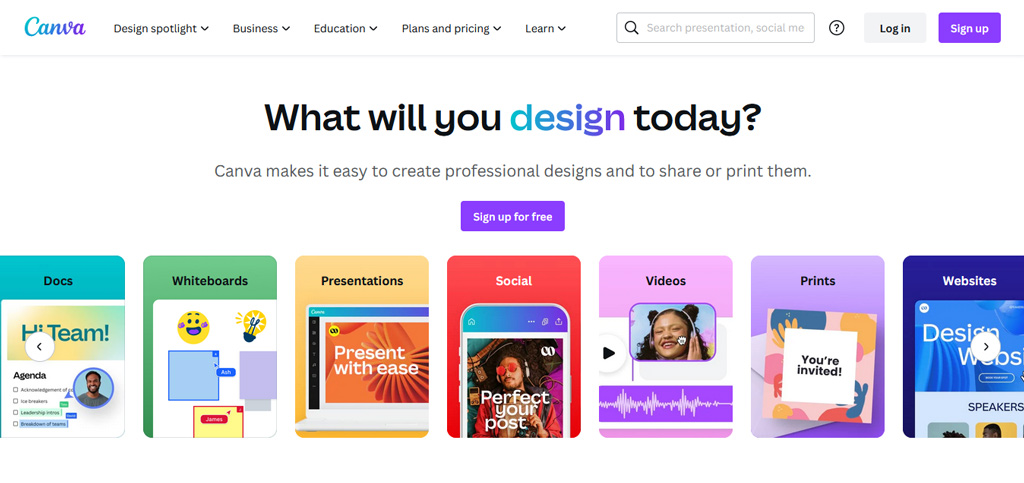
Canva: This user-friendly platform boasts an extensive library of design templates ideal for repurposing content for social media. Whether it’s infographics, banners, or social media posts, Canva simplifies the design process.
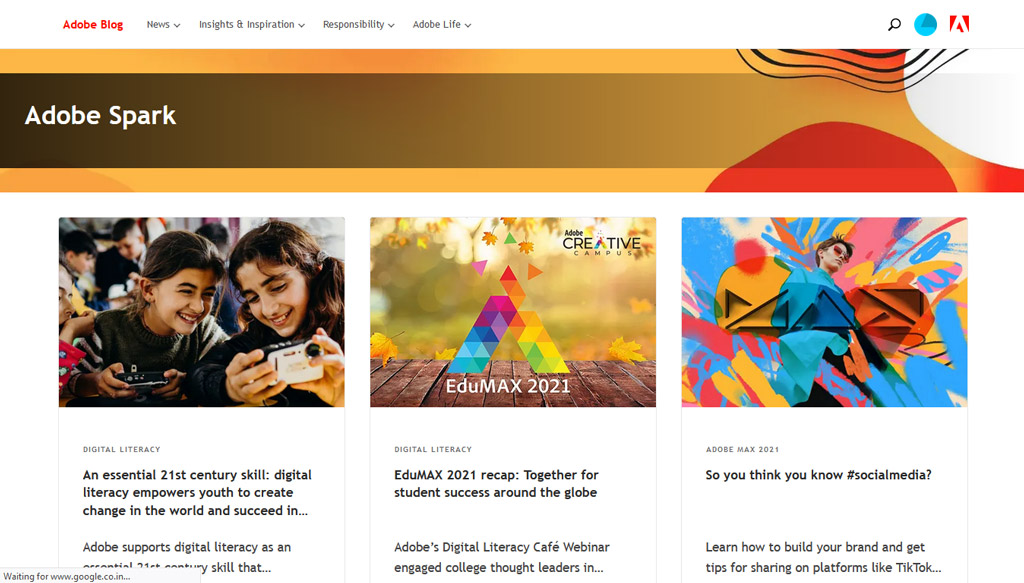
Adobe Spark: With its instant layouts and dynamic design capabilities, Adobe Spark makes it easy to create visually arresting content suitable for different platforms.
2. Video Tools
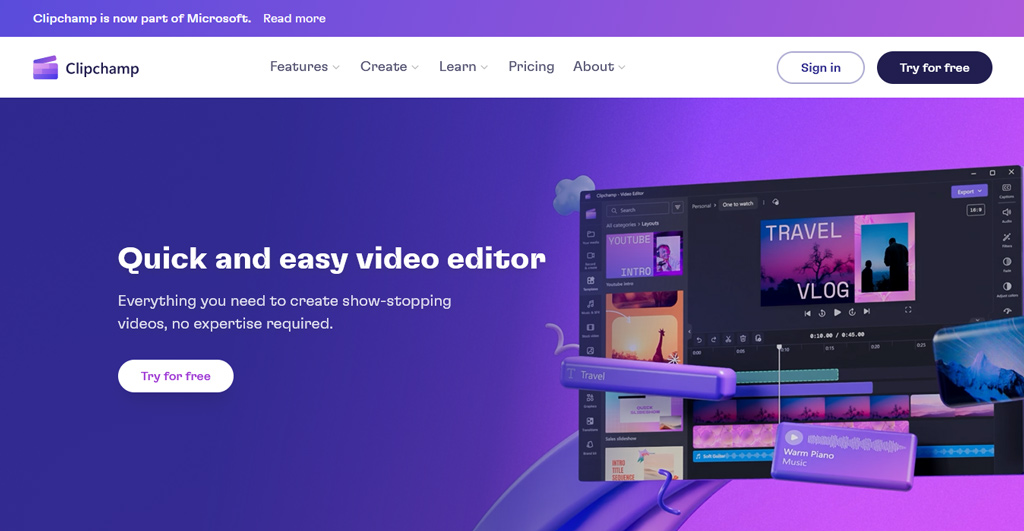
Clipchamp: For those who want to dive into video repurposing without the hassle, Clipchamp offers a fast video editor that streamlines video creation and adaptation.
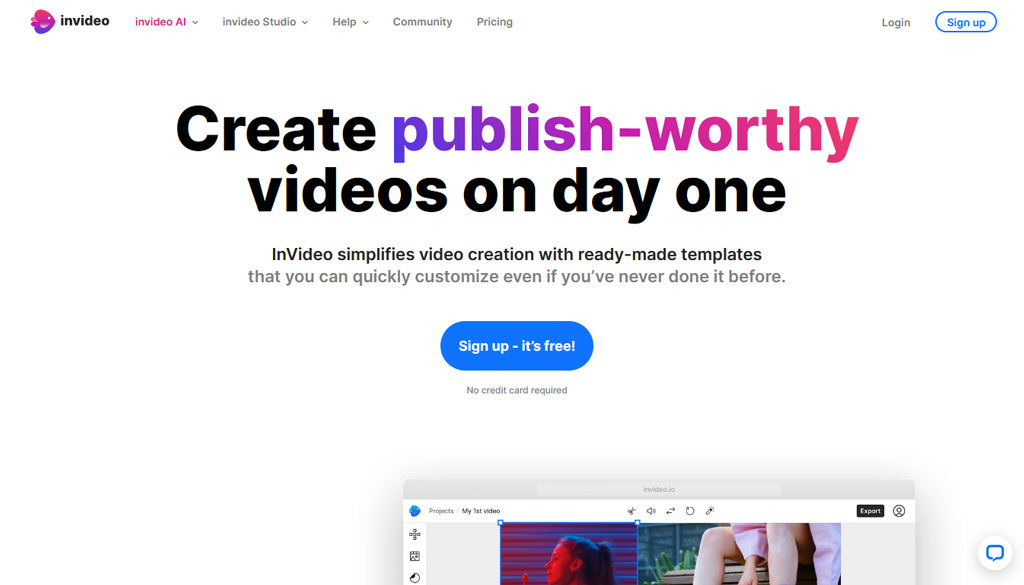
InVideo: With a plethora of ready-made templates, InVideo assists creators in swiftly churning out videos optimized for social media sharing.
3. Automation Tools
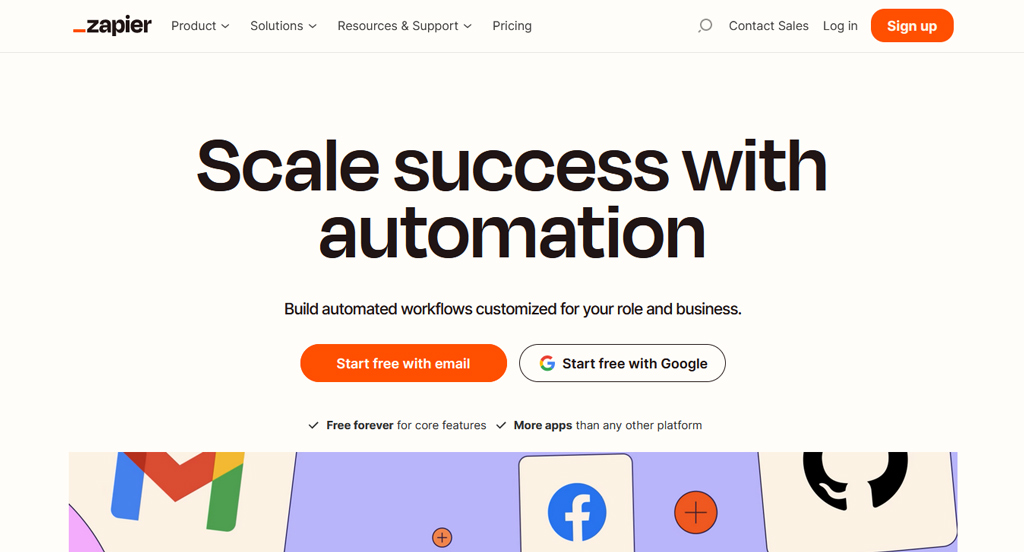
Zapier: Repurposing content for social media can involve various moving parts, and Zapier’s content triggers help automate some of these processes. By connecting different apps and setting up “Zaps”, you can automate tasks like posting content across platforms.

IFTTT (If This Then That): With its ability to set up conditional actions based on specified triggers, IFTTT simplifies cross-platform content sharing and ensures your repurposed content reaches the right channels seamlessly.
4. Pre-made Templates
For those times when quick turnarounds are essential, having a repository of pre-made templates is a lifesaver. These templates, tailored for various platforms and content types, speed up the process of repurposing content for social media.
Platforms like HubSpot, Trello, and several others offer such resources that can be customized as per brand aesthetics.
Repurposing Content for Social Media: High Quality, Quick Turnarounds
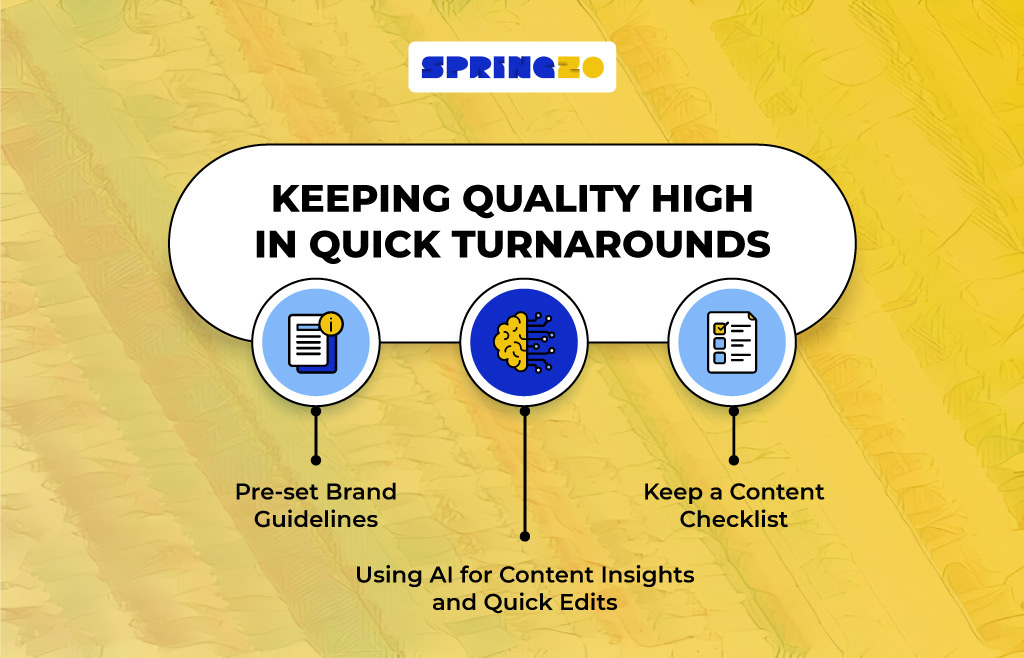
Quick turnarounds shouldn’t come at the expense of the content’s integrity and alignment with your brand. Fortunately, there are strategies and tools available to ensure that in social media, your content forever remains top-notch:
1. Pre-set Brand Guidelines
Before you dive into repurposing content for social media, establish clear brand guidelines. These guidelines should cover everything from color palettes and typography to voice and messaging. With a solid foundation, you can make fast design choices that consistently reflect your brand’s identity and ethos.
2. Using AI for Content Insights and Quick Edits
The power of artificial intelligence isn’t just confined to complex tasks. Several AI-driven tools offer content insights, suggest optimizations, and even automate edits.
Such tools scan your content, ensuring it aligns with best practices and remains engaging for the audience. By leveraging AI in repurposing content for social media, you get the dual benefit of speed and precision.
3. Keep a Content Checklist
As elementary as it sounds, a checklist is a lifesaver when working against the clock. Draft a comprehensive content checklist that outlines essential elements every piece should possess. This might include factors like CTA placement, keyword usage, or image quality.
Before publishing or sharing any repurposed content, run it through this checklist to ensure it resonates with your brand’s voice, values, and the quality standards you uphold.
By integrating these strategies into your repurposing workflow, you ensure that every piece, no matter how quickly produced, stands as a testament to your brand’s commitment to excellence.
Repurposing Content for Social Media: Tracking the Efficiency and Impact
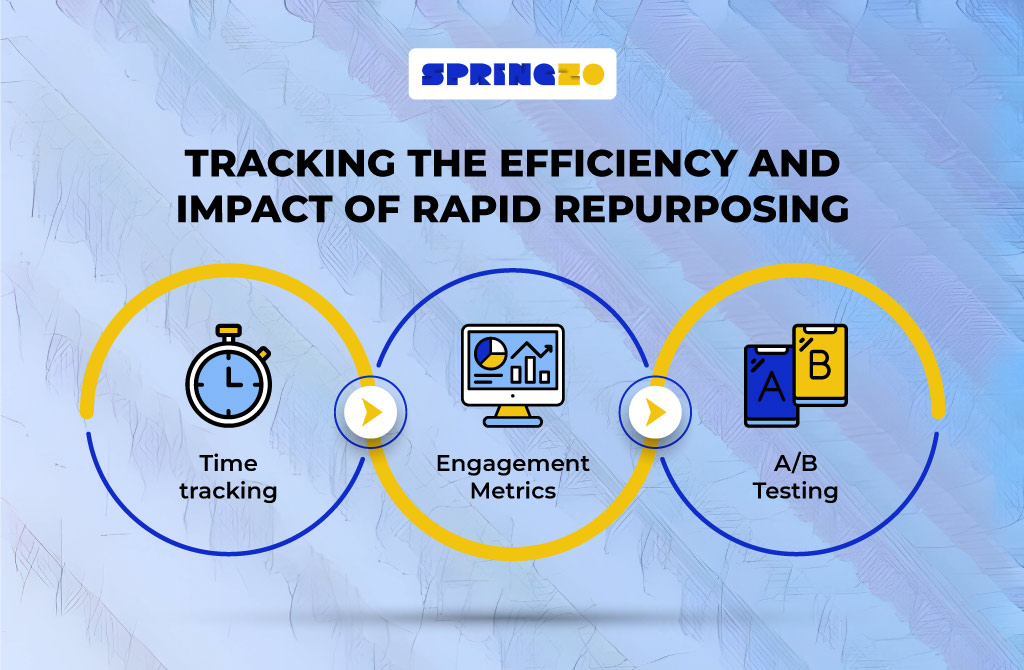
As with any digital strategy, it’s crucial to have metrics and tools in place to assess the impact of your repurposed content to ensure that your strategies are aligned with your goals and are delivering optimal ROI.
1. Time-tracking
To genuinely understand the efficiency of your repurposing content for social media endeavors, it’s vital to measure the actual time spent.
Tools such as Toggl or Harvest can help you track the minutes or hours dedicated to repurposing tasks, offering insights into how much time you save than creating new content from scratch.
2. Engagement Metrics
Rapidly repurposed content is of no value if it doesn’t engage your target audience. Utilize analytics tools on platforms like Facebook Insights, Instagram Analytics, or Google Analytics to track engagement metrics, such as clicks, shares, likes, and more.
By comparing these metrics, you can determine how your quickly-produced content fares versus traditionally produced content.
3. A/B Testing
The true test of any content strategy lies in comparison. By employing A/B testing, you can pitch your rapidly repurposed content against longer-formatted or traditionally produced content.
Tools like Optimizely or VWO can help facilitate these tests, providing data on which version of your content resonates more with your audience. This not only gauges the impact of your rapid repurposing but also provides insights for refining your strategy further.
Harnessing the Dual Power: Swift Repurposing & Sustained Quality
Striking a harmonious balance between speed and quality is crucial when you are repurposing content for social media. While the pressure of timely content delivery is undeniable, one must never lose sight of the intrinsic value of the content being shared.
Every article, infographic, or video you’ve previously produced shouldn’t be seen as a concluded chapter but rather as a treasure trove. Within them lie boundless opportunities for re-engagement, renewed interest, and fresh conversations. So, instead of perceiving them as static, think of them as dynamic assets ready to be reimagined, reshaped, and reintroduced to different segments of your audience.
At Springzo, our philosophy has always been anchored in unlocking the latent potential of content. Recognizing the vast prospects of repurposing content for social media, we’ve positioned ourselves as pioneers in this transformative journey.
Whether morphing a detailed blog post into a string of compelling tweets, crafting striking infographics from deep-dive insights, or carving out bite-sized video clips from extensive analyses, Springzo is your partner in ensuring that content transformation is both artful and impactful.
With a wealth of expertise, cutting-edge tools, and a finger on the digital pulse, our team guarantees that your repurposed content not only resonates but reignites interest and engagement.
Dive into the world of content repurposing with Springzo and watch your narratives captivate like never before.
Frequently Asked Questions (FAQs)
1. What are some common pitfalls to avoid when repurposing content for social media?
While repurposing is a powerful tool, it’s essential to avoid misaligning content with the wrong platform. For example, long-form content might not be ideal for platforms favoring bite-sized content like Twitter. Also, always ensure that your repurposed content remains relevant to current trends and audience interests.
2. How often should I look at my old content for repurposing opportunities?
A quarterly review of your content archives can be beneficial. This regular check allows you to align old content with new trends, seasonal opportunities, or company goals. Moreover, as your audience grows and evolves, what was once old can be new and relevant to newer followers or subscribers.
3. Can repurposed content negatively impact SEO if it appears redundant?
When repurposing content, especially for different platforms, the chances of negatively impacting SEO are minimal. However, if you’re republishing content on the same platform or a different website, it’s vital to use canonical tags or ensure the content is sufficiently differentiated to avoid potential duplicate content issues.
4. How do I gauge the ROI of my repurposed content versus newly created content?
You can use analytics tools to measure metrics like engagement, reach, and conversion for both repurposed and new content. By comparing these metrics over similar durations, you’ll get a clear picture of performance. It’s also worth considering the time and resources saved in repurposing versus creating fresh content when evaluating ROI.
5. Are there specific types of content that are more suited to repurposing than others?
Evergreen content, which remains relevant over time, is particularly well-suited for repurposing. This includes how-to guides, tutorials, and in-depth research. However, with creativity, almost any content can be given a fresh spin and repurposed for different platforms or formats.
